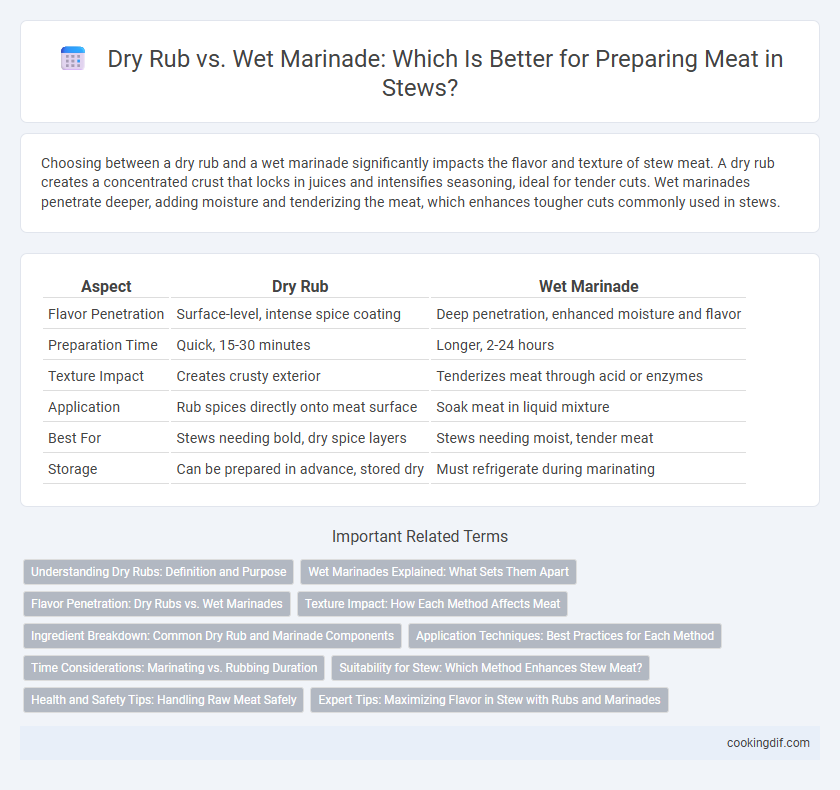Choosing between a dry rub and a wet marinade significantly impacts the flavor and texture of stew meat. A dry rub creates a concentrated crust that locks in juices and intensifies seasoning, ideal for tender cuts. Wet marinades penetrate deeper, adding moisture and tenderizing the meat, which enhances tougher cuts commonly used in stews.
Table of Comparison
| Aspect | Dry Rub | Wet Marinade |
|---|---|---|
| Flavor Penetration | Surface-level, intense spice coating | Deep penetration, enhanced moisture and flavor |
| Preparation Time | Quick, 15-30 minutes | Longer, 2-24 hours |
| Texture Impact | Creates crusty exterior | Tenderizes meat through acid or enzymes |
| Application | Rub spices directly onto meat surface | Soak meat in liquid mixture |
| Best For | Stews needing bold, dry spice layers | Stews needing moist, tender meat |
| Storage | Can be prepared in advance, stored dry | Must refrigerate during marinating |
Understanding Dry Rubs: Definition and Purpose
Dry rubs consist of a blend of powdered spices and herbs applied directly to meat, enhancing flavor through a concentrated seasoning layer that penetrates the surface during cooking. Unlike wet marinades, dry rubs do not introduce moisture, resulting in a textured outer crust that locks in natural juices and intensifies taste. Common ingredients include salt, paprika, garlic powder, and black pepper, each contributing to the depth and complexity of the final stew dish.
Wet Marinades Explained: What Sets Them Apart
Wet marinades penetrate meat fibers through moisture and acidity, enhancing flavor and tenderness by breaking down proteins. Typically composed of oil, vinegar, citrus juice, herbs, and spices, wet marinades create a moist environment that helps retain juiciness during cooking. This method contrasts with dry rubs by infusing deeper, more evenly distributed flavors and improving texture, especially in tougher cuts used for stews.
Flavor Penetration: Dry Rubs vs. Wet Marinades
Dry rubs consist of a blend of spices and herbs that adhere to the meat's surface, creating a flavorful crust but offering limited flavor penetration beyond the outer layer. Wet marinades, typically composed of acidic components like vinegar or citrus combined with oil and seasonings, enable deeper infiltration of flavors into the meat fibers due to their liquid medium. This difference in flavor penetration means wet marinades are more effective for tenderizing and imparting complex taste profiles throughout the meat, while dry rubs enhance surface texture and concentrated seasoning.
Texture Impact: How Each Method Affects Meat
Dry rubs create a firm crust on the meat's surface, enhancing texture by sealing in juices and adding a slightly crispy exterior. Wet marinades penetrate deeper, tenderizing the meat and producing a moist, succulent interior with a more uniform flavor distribution. The choice between dry rub and wet marinade significantly influences the final texture, balancing between a robust outer crust and tender, juicy meat.
Ingredient Breakdown: Common Dry Rub and Marinade Components
Dry rubs commonly contain a blend of spices such as paprika, cumin, garlic powder, salt, and brown sugar, designed to create a flavorful crust on meat. Wet marinades typically combine acidic components like vinegar or citrus juice, oils, herbs, and spices to tenderize and infuse moisture into the meat. Both methods use salt and aromatic elements, but dry rubs emphasize spice concentration while marinades rely on liquid absorption for meat preparation.
Application Techniques: Best Practices for Each Method
Dry rubs are best applied by evenly massaging the spice blend onto the surface of the meat to create a flavorful crust that enhances caramelization during cooking. Wet marinades require submerging the meat completely and refrigerating for several hours to allow acidic ingredients like vinegar or citrus juice to tenderize and infuse the meat with moisture and flavor. For optimal results, use dry rubs on meats cooked with high heat such as grilling or roasting, while wet marinades are ideal for slow cooking methods like stewing to ensure deep penetration and tenderness.
Time Considerations: Marinating vs. Rubbing Duration
Dry rubs require less time, typically 30 minutes to 2 hours, as their salt and spices penetrate the meat quickly. Wet marinades demand longer durations, often 4 to 24 hours, to allow acidic or enzymatic components to tenderize and flavor the protein deeply. Timing affects texture and taste, with dry rubs offering a faster flavor boost and marinades providing more intense, tenderizing effects over extended periods.
Suitability for Stew: Which Method Enhances Stew Meat?
For stew meat preparation, dry rubs enhance flavor penetration without adding excess moisture, preserving the stew's rich, thick texture. Wet marinades infuse meat with moisture and acidity, tenderizing tougher cuts and complementing slow-cooked stews. Choosing a wet marinade is typically more suitable for stew, as it breaks down connective tissues and enriches the overall flavor profile during extended cooking times.
Health and Safety Tips: Handling Raw Meat Safely
When preparing stew, handling raw meat safely is crucial to prevent cross-contamination and foodborne illnesses. Use separate cutting boards and knives for raw meat, wash hands thoroughly with soap and warm water before and after touching meat, and always marinate in the refrigerator to inhibit bacterial growth. Whether using a dry rub or wet marinade, discard any leftover marinade that has come into contact with raw meat to eliminate the risk of contamination.
Expert Tips: Maximizing Flavor in Stew with Rubs and Marinades
Using a dry rub for stew meat intensifies flavor through direct spice adhesion, creating a robust crust during browning that enhances depth and aroma. Wet marinades, rich in acids and oils, tenderize meat fibers while infusing moisture and complementary herbs, resulting in a succulent, well-rounded stew texture. For optimal stew preparation, combine a dry rub with a brief marinating period to balance concentrated seasoning and tenderness, maximizing flavor complexity.
Dry rub vs wet marinade for meat prep Infographic

 cookingdif.com
cookingdif.com